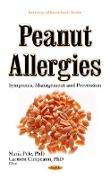- Start
- Peanut Allergies
Peanut Allergies
Angebote / Angebote:
Food allergies have a considerable impact on modern society. Some of the most severe allergic reactions occur when peanuts and peanut derivatives are consumed. The main causative agents of a peanut allergy are proteins. The total protein content of a peanut is represented by thirty-two different proteins, of which about eighteen (nearly 7-10%) have been identified as capable of binding specific IgE, and so can be considered allergenic. Comprised of six chapters, this book comprehensively covers all topics of peanut allergy. A unique, concise and up-to-date resource, it offers readers an innovative and valuable presentation of the subject. It has been carefully prepared to present the concepts with the help of diagrams and tables. Each chapter is presented in a simple and systematic way to provide a thorough understanding of the core aspects of peanut allergy and the components of peanuts which cause allergic reactions. The basic concepts of clinical aspects, peanut allergens properties, cross reactivity and stability of peanut allergens and the legislation to protect sensitive people are clearly explained. Recent discoveries of peanut allergens are highlighted. From the description of the first peanut allergen called Ara h1 in 1991, so far there have been about thirteen proteins with allergenic action described. Theallergenic proteins in a peanut, named Ara h1 Ara h17 and agglutinin have been identified, largely characterised and accepted by the Allergen Nomenclature Subcommittee of the International Union of Immunological Societies (IUIS). Some of these allergens have established structural features, biochemical and physicochemical properties and their biosynthesis genes encoded. Being proteins, peanut allergens can suffer some modifications during food processing and digestion (acylation, polymerisation, nitration, Maillard reaction etc.), and interactions within complex food matrices (both natural and fabricated structures). These modifications can reduce or increase their allergenic properties and are influenced by the food matrix. Peanut allergens have different cross-reactions with other allergens such as, for example, those of soybean, peas, lima beans, green beans, chickpeas, lentils or other beans. Methods commonly used to detect and quantify peanut allergens are mainly immunochemical and molecular methods. However, methods have been developed based on HPLC techniques coupled both with and without mass spectrometry, capillary electrophoresis, circular dichroism, FTIR or NMR. Peanut allergy is high and there is currently no treatment for it. There is a lethal risk associated with peanut allergy, and in order to protect public health, the regulatory bodies worldwide will issue legislation concerning a requirement to clearly have a warning label of the possible presence of food allergens. The last chapter contains some of the most used preventive actions and elaborated legislation in different countries.
Folgt in ca. 15 Arbeitstagen




